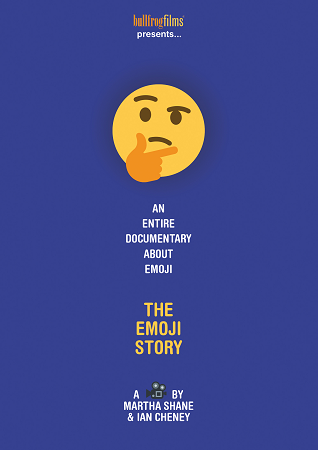
The Emoji Story 2021
Distributed by Bullfrog Films, PO Box 149, Oley, PA 19547; 800-543-FROG (3764)
Produced by Ian Cheney, Jennifer 8. Lee, and Martha Shane
Directed by Martha Shane and Ian Cheney
Streaming, 79 mins
Middle School - General Adult
Communication; Computer Science; Documentaries; Linguistics; Media Studies; Philosophy; Popular Culture; Sociology; Women’s Studies
Date Entered: 10/12/2021
Reviewed by Jennifer Dean, Film Editor, Filmmaker, Film CuratorThe Emoji Story follows the journey of the emoji from its creation by Shigetaka Kurita in 1997 to present day where its use has evolved, arguably into a language, well beyond the simple symbols Kurita originally introduced. I was recently gifted a dictionary by my mother which was originally a present she herself received from my father when she first moved to the United States. No doubt it was a gift given partly to tease her about her native tongue, the English she had learned in the United Kingdom. This dictionary, The American Heritage Dictionary of the English Language, contains thousands of entries but of course is missing many since a plethora of words have come to fruition since its publication in 1971. Language constantly evolves and, as this film demonstrates, emojis are now part of that evolution.
Directors Ian Cheney and Martha Shane illustrate the possibilities and pitfalls of this by featuring three emoji proposals being submitted to Unicode, the body in Silicon Valley that controls the worldwide implementation of emojis across all applications: a Muslim teenager proposing an emoji of a woman in a hijab; women from Argentina looking to have their national drink mate included in pictorial possibilities; and a non-profit advocacy group for young women in England nominating a period emoji to normalize communication around menstruation. The Emoji Story demonstrates that this international language of pictures has the possibility to create a more inclusive cultural discourse - but only if the Unicode committee deems it so. This group, of course, has its own biases. As one member jokes, she believes there are very few vegetable emojis because most subcommittee members don’t like vegetables. Of course, there is a benefit to keeping the system limited in characters both for ease of use and to keep it manageable in terms of data for devices.
Delving deeply into the social and linguistic significance of the emoji, the filmmakers interview linguists, scholars, average users, and members of the Unicode consortium to create a greater understanding of how and why emojis are used and the semantic development of this new form of communication. Initially, I was struck by how successfully the filmmakers edited together a cohesive and comprehensive documentary without the use of narration or voice-over, often necessary to solidify a story or clarify complex thoughts in the documentary format. Upon subsequent viewing, it struck me that narration artistically appears in the form of graphics of emojis, along with English subtitles, to tie the story together. The filmmakers have cleverly created a film which artistically uses emojis as narration to tell the story of emojis, thus the style highlights the content.
The Emoji Story provides an opportunity for discourse on language and communication and would be an asset to any course in that vein, not exclusively in relation to the subject of modern digital forms but also as a launching off point for a conversation about traditional language. Jennifer 8 Lee, the founder of Emojination, an organization which advocates for the use of more inclusive emojis, describes the use of Chinese characters in terms of gender, underscoring the influence language has on culture and vice versa. Language is, of course, constantly changing but it has usually been more gradual and somewhat less codified than what occurs with the Unicode emoji submission process. The Merriam-Webster Dictionary website explains, “A word gets into a dictionary when it is used by many people who all agree that it means the same thing.” To quote one of the supporters for the period emoji campaign in this film, this is the first time “any language has been decision by committee,” with the arbiters being the Unicode committee.
As one scholar points out in an interview, emojis will never replace the intricacy of language that has evolved over hundreds of years to tackle complex subjects but they definitely serve a function. This film gives new insight into the pictorial language of the emoji and society, culture, representation and language on a larger scale and is highly recommended for courses on documentary filmmaking, language, sociology, communication, women’s studies, and more.
Awards: Official Selection - Tribeca Film Festival, Hot Docs, AFI Docs Film Festival, Sydney Film Festival, Cleveland International Film Festival, Heartland International Film Festival, Milano Design Festival, Woods Hole Film Festival, Traverse City Film Festival, American Film Showcase, Hawaii International Film Festival, Melbourne International Film Festival, Sedona Film Festival, Rocky Mountain Women's Film Festival, SF Doc Festival, Durango Independent Film Festival, Southern Circuit Tour of Independent Filmmakers, Doc Edge Film Festival, Design Film Festival, Singapore, ARTRussia Film Festival,Oxford Film Festival, DOCtober Film Festival, Taormina Film Festival, Lake Country Film Festival, Three Rivers Film Festiva, Castlemaine Documentary Film Festival, 41 North Film Festival
Published and licensed under the Creative Commons Attribution 4.0 license. Anyone can use these reviews, so long as they comply with the terms of the license.